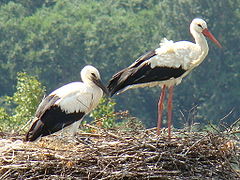- Ciconia
-
For the composer with this name, see Johannes Ciconia.
Ciconia 
Fledgling (left) and adult
European White Stork (Ciconia ciconia ciconia)Scientific classification Kingdom: Animalia Phylum: Chordata Class: Aves Order: Ciconiiformes Family: Ciconiidae Genus: Ciconia
Brisson, 1760Species Ciconia abdimii
Ciconia boyciana
Ciconia ciconia
Ciconia episcopus
Ciconia maguari
Ciconia nigra
Ciconia stormiSynonyms Xenorhynchus
Ciconia is a genus of birds in the stork family. Six of the seven living species occur in the Old World, but the Maguari Stork has a South American range. In addition, fossils suggest that Ciconia storks were somewhat more common in the tropical Americas in prehistoric times.
These are large storks, typically 100 cm tall, with a 180 cm wingspan and a long thick bill. Members of this genus are more variable in plumage than other storks, but several species have black upper bodies and wings, and white belly and undertail. Juveniles are a duller, browner version of the adult.
Ciconia storks are gregarious and colonial breeders, and pairs stay together for life. They typically build large stick nests in trees, although the Maguari Stork will nest on the ground and at least three species will construct their nests on human habitations. One of these, the White Stork, is probably the best known of all storks, with a wealth of legend and folklore associated with this familiar visitor to Europe.
These storks feed on frogs, insects, young birds, lizards and rodents. They fly with the neck outstretched, like most other storks, but unlike herons which retract their neck in flight.
The migratory species like the White Stork and the Black Stork soar on broad wings and rely on thermals of hot air for sustained long distance flight. Since thermals only form over land, these storks, like large raptors, must cross the Mediterranean at the narrowest points, and many of these birds can be seen going through the Straits of Gibraltar and the Bosphorus on migration.
Species
- Abdim's Stork, Ciconia abdimii
- Woolly-necked Stork, Ciconia episcopus
- Storm's Stork, Ciconia stormi
- Maguari Stork, Ciconia maguari
- Oriental White Stork, Ciconia boyciana
- White Stork, Ciconia ciconia
- Black Stork, Ciconia nigra
The fossil record of the genus is extensive, indicating that Ciconia storks were once more widespread than they are today. Although the known material tends to suggest that the genus evolved around the Atlantic, possibly in western Europe or Africa, the comparative lack of fossil sites in Asia makes this assumption not well-founded presently. All that can be said is that by the Early Pliocene, Ciconia was widespread at least all over the Northern Hemisphere.
Fossil members of the genus include:
- ?Ciconia minor (Early Miocene of Rusinga Island, Kenya)
- ?Ciconia sarmantica (Late Miocene of Credinţa, Romania)
- ?Ciconia gaudryi (Late Miocene/Early Pliocene of Pikermi, Greece)
- Ciconia sp. 1 (Late Miocene/Early Pliocene of Lee Creek Mine, USA)
- Ciconia sp. 2 (Late Miocene/Early Pliocene of Lee Creek Mine, USA)
- ?Ciconia kahli (Early Pliocene of South Africa)
- Mongolian Stork, Ciconia lucida (Middle Pliocene of Mongolia)
- Asphalt Stork, Ciconia maltha (Late Pliocene - Late Pleistocene of W and S USA, and Cuba)
- Ciconia stehlini (Late Pliocene - Early Pleistocene of Hungary) - may belong to extant species
- Australian Stork, Ciconia nana (Late Pleistocene of Australia) - formerly Xenorhynchus[1]
- Ciconia sp. (Late Pleistocene/Early Holocene of Las Breas de San Felipe, Cuba)[2]
A distal radius in Late Pleistocene deposits of San Josecito Cavern (Mexico) may belong in this genus or in Mycteria; it is smaller than that of any known American stork, Ciconia or otherwise[3]. The proposed fossil genus Prociconia from Brazil, also of Late Pleistocene age, may be a junior synonym of either this genus or Jabiru. A Ciconia bone found in a rock shelter on Réunion was probably of a bird taken there as food by early settlers; no known account mentions the presence of storks on the Mascarenes.
Footnotes
- ^ Boles. W 2005 A Review of the Australian Fossil Storks of the Genus Ciconia (Aves: Ciconiidae), With the Description of a New Species
- ^ MNHNCu P4599, a distal right tibiotarsus of a mid-sized species, about the size of the White Stork: Suárez & Olson (2003)
- ^ Steadman et al. (1994)
References
- Barlow, Clive (1997): A field guide to birds of the Gambia and Senegal. Pica Press, Nr. Robertsbridge (East Sussex). ISBN 1-873403-32-1
- Grimmett, Richard; Inskipp, Carol, Inskipp, Tim & Byers, Clive (1999): Birds of India, Pakistan, Nepal, Bangladesh, Bhutan, Sri Lanka, and the Maldives. Princeton University Press, Princeton, N.J.. ISBN 0-691-04910-6
- Hilty, Steven L. (2003): Birds of Venezuela. Christopher Helm, London. ISBN 0-7136-6418-5
- Steadman, David W.; Arroyo-Cabrales, Joaquin; Johnson, Eileen & Guzman, A. Fabiola (1994): New Information on the Late Pleistocene Birds from San Josecito Cave, Nuevo León, Mexico. Condor 96(3): 577-589. DjVu fulltext PDF fulltext
- Suarez, William & Olson, Storrs L. (2003): New Records of Storks (Ciconiidae) from Quaternary Asphalt Deposits in Cuba. Condor 105(1): 150-154. DOI:10.1650/0010-5422(2003)105[150:NROSCF]2.0.CO;2 HTML abstract
External links
- ARKive: images and movies of Ciconia boyciana
- Ciconia videos on Internet Bird Collection:
- Ecological education through live white storks' nest webcam observation
Storks (order: Ciconiiformes • family: Ciconiidae) Genus Mycteria Milky Stork (M. cinerea) • Yellow-billed Stork (M. ibis) • Painted Stork (M. leucocephala) • Wood Stork (M. americana)Anastomus Asian Openbill (A. oscitans) • African Openbill (A. lamelligerus)Ciconia Abdim's Stork (C. abdimii) • Woolly-necked Stork (C. episcopus) • Storm's Stork (C. stormi) • Maguari Stork (C. maguari) • Oriental Stork (C. boyciana) • White Stork (C. ciconia) • Black Stork (C. nigra)Ephippiorhynchus Black-necked Stork (E. asiaticus) • Saddle-billed Stork (E. senegalensis)Jabiru American Black-necked Stork or Jabiru (J. mycteria)Leptoptilos 19 living species in six genera Categories:- Ciconia
- Storks
- Genera of birds
Wikimedia Foundation. 2010.
